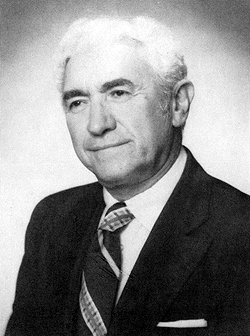By Dr. Sol Taylor
"Making Cents"
Saturday, September 22, 2007
| T |
|
Abe made his mark when almost every rare coin and major collection came to light; he was in the midst of it.
In an interview with Ed Reiter of COINage Magazine in 1982 shortly before his untimely death from a brain tumor, Abe answered the question of "the good old days." Basically he recounted that collecting was more fun than a profit venture. In some cases it was a contest among selected collectors who could get the best or the most complete set of a specific series of coins.
In addition, the "good" experiences tended to outshine the poor experiences by the process of "selective memory." Abe said, "I am glad not to be starting out today in the business — everything is investment — what is the cost and how much can I make?"
In the old days, most collectors were very knowledgeable, and in lieu of textbooks in the field with few exceptions, collectors relied on each other and their favorite dealers for numismatic advice — such as die varieties in early U.S. coins. Coin shops often resembled social halls where collectors often spent hours (and few dollars) to exchange ideas, show off coins, and do a little trading.
Harvey G. Stack remembered, "In those days, coin shops were more like clubhouses than showrooms."
I even spent some time perusing the half-cent inventory at Stack’s around 1945 and finally spent a whole dollar on two well-used pieces.
I would often spend much of a Saturday at Hans Sergl's shop on Fulton Street, looking over his whole inventory while he would spend much of the same time playing chess with customers and other shop owners from nearby Nassau Street.
Old catalogs were in big demand regardless of condition — often dogeared copies of 19th-century catalogs with penciled markings in the margins were treated as gem numismatic rarities (which often they were).
Abe pointed out that the early 1960s saw a turning point in the hobby. Coin shows grew to great size as many newcomers became full time dealers. Coin World hit the weekly market with huge ads and news stories. Rolls of coins were traded as commodities — with full-page ads featuring rolls of cents through halves from 1934 to date (Manchester Coins of Los Angeles, for example).
Since then, Abe said in the Reiter interview, "The dyed-in-the-wool collector had taken a back seat — and this was a shame."
I knew Abe even when he was in New York City as a partner with Abner Kreisberg. I had dealings with Abe when he was in Encino. And in 1976 I was dating his daughter when they lived in Palm Springs.
I was also a good friend of Maurice M. Gould, a contemporary of Kosoff and longtime friend and trading partner. Gould, headquartered in Boston at Copley Coin Co. with Frank Washburn, also handled many of New England's finest colonial and early American coin holdings; many pieces at one time appeared in earlier editions of "A Guide Book of United States Coins" (the "Red Book") as "Copley Copies." Since some pieces were one-of-a-kind, Gould had copies made for collectors, and these pieces were used for "Red Book" illustrations for some years.
Gould passed away in November 1975, and I recall standing next to Abe at the funeral lamenting his passing and the loss of another stalwart from the "old days" of numismatics.
The membership of the American Numismatic Association has reflected the ups and downs in numismatics. During most of the active years of old-timers such as Kosoff, Gould, the Stack brothers, John J. Pittman, John J. Ford, the Guttag Brothers, Hans Sergl (a long time downtown New York City shop owner and a source of most of my early coin collections), Bob Zurcher, Q. David Bowers (who started out as a high schooler and still is at the top of the numismatic world today), Sol Kaplan, Art Kagin, B. Max Mehl and many similar giants held the reins of the ANA steady for decades.
Membership numbers were in the double and triple digits. Mine is L-805 (life member since 1964), and as collecting hit new highs during the silver and gold craze, the new 50-state quarters and other peak moments, the ANA membership now stands at 32,000 with life members numbering more than 5,000.
Collecting is more often investment-driven as auction prices set new records regularly. Peak prices are hit for "Set Registry" coins — those with the highest grades assigned by the major grading services.
Kenneth Bressett, editor of the "Red Book," added to the story by stating, "Maybe we had more fun (back then), because there wasn't much else to have but fun. In those days, prices didn't go up very fast. So you didn't make much money on your coins — and for that very reason, fun became the hobby's key element."
"You can still have fun," he added. "You just have to go about it a little differently. And after all, making money can be fun sometimes, too."
Dr. Sol Taylor of Sherman Oaks is president of the Society of Lincoln Cent Collectors and author of The Standard Guide to the Lincoln Cent. Click here for ordering information.
©2007 SCV COMMUNICATIONS GROUP & SOL TAYLOR · ALL RIGHTS RESERVED.

![[Most Recent Quotes from www.kitco.com]](http://www.kitconet.com/images/quotes_special.gif)

